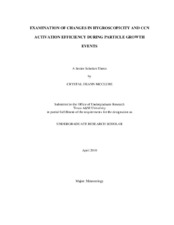| dc.description.abstract | The growth and evolution of newly formed atmospheric particles were examined using an array of instruments located at a rural site northwest of Houston, TX. The focused study described here was designed to evaluate the influence of nucleated particles on same day and next day CCN concentrations. An integrated differential mobility analyzer / tandem differential mobility analyzer / CCN counter was used to track the size, hygroscopicity, and cloud nucleating efficiency of the population of particles that formed during the morning and grew throughout day and into the night. As has been observed using similar instrumentation at other locations, the hygroscopicity of the recently formed particles exhibited a diel pattern having a maximum in the early afternoon and a minimum before sunrise. To attribute the growth and evolving properties of these particles to the responsible mechanisms, complementary measurements of gas phase precursors and oxidants, which were made concurrently to particle measurements, will be compared in a future project. Of particular interest would be the link between nighttime nitrate radical concentration and the rates at which the diameter of the particles increased and at which their critical supersaturation decreased. Ultimately, these data can help constrain the relative importance of organic and inorganic precursors and of differing oxidants to the production of CCN in regions for which both anthropogenic and biogenic emissions sources are significant. | en |


